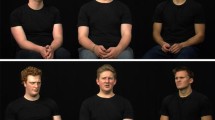Abstract
Research of the past two decades has shown that cultures exert considerable influence over emotion. Most, if not all, of the cross-cultural research reported to date have been on samples obtained in different countries. Although it is important to address questions of cross-cultural similarities and differences via the testing of between-country differences, we need to be concerned with possible cultural differenceswithin countries as well. The assessment of cultural differences within countries would have implications for not only our conceptual understanding of cultural influences on emotion, but also our empirical methods and procedures. In this study, American subjects were self-classified into one of four ethnic groups, and provided us with data concerning affect intensity, display rule attitudes, self-reported emotional expression, emotion labeling, and intensity ratings. The results indicated considerable differences in emotion judgments, display rules, and self-reported emotional expressions as a function of ethnicity within an American sample. The differences are discussed in terms of the need to search for psychologically meaningful and relevant definitions of culture which would cut across ethnicity or country.
Similar content being viewed by others
References
Ekman, P. (1972). Universals and cultural differences in facial expressions of emotion. In J. Cole (Ed.),Nebraska Symposium on Motivation. Lincoln: University of Nebraska Press.
Ekman, P., & Friesen, W. V. (1971). Constants across cultures in the face and emotion.Journal of Personality and Social Psychology, 17 124–129.
Ekman, P., & Friesen, W. V. (1975).Unmasking the face: A guide to recognizing emotions from facial clues. Englewood Cliffs, NJ: Prentice-Hall.
Ekman, P., & Friesen, W. V. (1978).Facial action coding system. Palo Alto, CA: Consulting Psychologists Press.
Ekman, P., Friesen, W. V., O'Sullivan, M., Chan, A., Diacoyanni-Tarlatzia, I., Heider, K., Krause, R., LeCompte, W., Pitcairn, T., Ricci-Bitti, P., Scherer, K., Tomita, M., & Tzavaras, A. (1987). Universals and cultural differences in the judgments of facial expressions of emotion.Journal of Personality and Social Psychology, 53 712–717.
Ekman, P., Sorenson, E. R., & Friesen, W. V. (1969). Pancultural elements in facial displays of emotion.Science, 164 86–88.
Friesen, W. V. (1972).Cultural differences in facial expression in a social situation: An experimental test of the concept of display rules. Unpublished doctoral dissertation, University of California, San Francisco.
Izard, C. E. (1971).The face of emotion. New York: Appleton-Century-Crofts.
Larsen, R. J., & Diener, E. (1987). Affect intensity as an individual difference characteristic: A review.Journal of Research in Personality, 21 1–39.
Matsumoto, D. (1986).Cross-cultural communication of emotions. Unpublished doctoral dissertation, University of California, Berkeley.
Matsumoto, D. (1989). Cultural influences on the perception of emotion.Journal of Cross-Cultural Psychology, 20 92–105.
Matsumoto, D. (1990). Cultural similarities and differences in display rules.Motivation and Emotion, 14 195–214.
Matsumoto, D. (1992). American-Japanese cultural differences in the recognition of universal facial expressions.Journal of Cross-Cultural Psychology, 23 72–84.
Matsumoto, D. (1993).Extraversion-introversion and judgments of emotion. Unpublished manuscript.
Matsumoto, D., & Ekman, P. (1988).Japanese and Caucasian facial expressions of emotion (JACFEE) and neutral faces (JACNeuf). [Slides]. San Francisco: San Francisco State University. Available from Emotion Research Laboratory, Department of Psychology, San Francisco State University, 1600 Holloway Avenue, San Francisco, CA 94132.
Matsumoto, D., & Ekman, P. (1989). American-Japanese cultural differences in intensity ratings of facial expressions of emotion.Motivation and Emotion, 13 143–157.
Matsumoto, D., & Hearn, V. (in press). Culture and emotion: Display rule differences between the United States, Poland, and Hungary.Motivation and Emotion.
Matsumoto, D. Kudoh, T., Scherer, K., & Wallbott, H. (1988). Emotion antecedents and reactions in the U.S. and Japan.Journal of Cross-Cultural Psychology, 19 267–286.
Scherer, K., Matsumoto, D., Wallbott, H., & Kudoh, T. (1988). Emotional experience in cultural context: A comparison between Europe, Japan, and the U.S.A. In K. Scherer (Ed.),Facets of emotion: Recent research. Hillsdale, NJ: Erlbaum.
Scherer, K. R., Wallbott, H., & Summerfield, A. (Eds.). (1986).Experiencing emotion: A cross-cultural study. Cambridge, England: Cambridge University Press.
Triandis, H. C., McCusker, C., & Hui, C. (1990). Multimethod probes of individualism and collectivism.Journal of Personality and Social Psychology, 59 1006–1020.
Vinacke, W. E. (1949). The judgment of facial expressions by three national-racial groups in Hawaii: I. Caucasian faces.Journal of Personality, 17 407–429.
Vinacke, W. E., & Fong, R. W. (1955). The judgment of facial expressions by three national-racial groups in Hawaii: II. Oriental faces.Journal of Social Psychology, 41 184–195.
Wallbott, H., & Scherer, K. R. (1986). How universal and specific is emotional experience? Evidence from 27 countries on five continents.Social Science Information, 25 763–796.
Zuckerman, M. (1990). Some dubious premises in research and theory on racial differences.American Psychologist, 45 1297–1303.
Author information
Authors and Affiliations
Additional information
This research was supported in part by a research grant from the National Institute of Mental Health (MH 42749-01), and by a faculty award for Creativity, Research, and Scholarship and a Faculty Affirmative Action Award from San Francisco State University. I would like to thank Andrea Chang for her assistance in the data collection; Ken Kokka for his editorial assistance on an earlier version of this manuscript; and Masami Kobayashi, Deborah Krupp, Mija Lee, Erika Maniatis, and Bill Roberts, for their aid on an earlier version of this article, and for their aid in my general research program.
Rights and permissions
About this article
Cite this article
Matsumoto, D. Ethnic differences in affect intensity, emotion judgments, display rule attitudes, and self-reported emotional expression in an American sample. Motiv Emot 17, 107–123 (1993). https://doi.org/10.1007/BF00995188
Issue Date:
DOI: https://doi.org/10.1007/BF00995188




